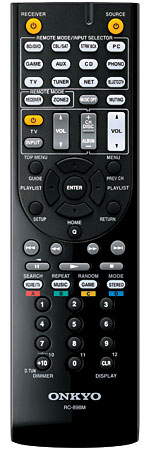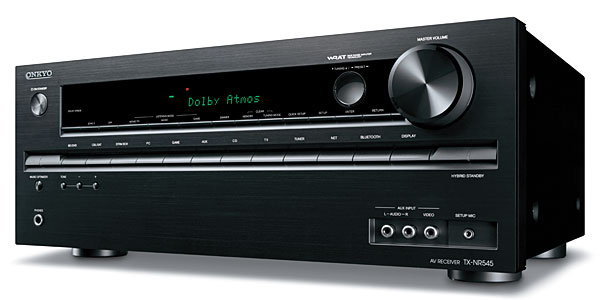Onkyo TX-NR545 Atmos-Ready AV Receiver Review Page 2
A Good Amp Always Helps
Although Onkyo has long competed more on features than on sound, the TX-NR545 is based on an intrinsically good-sounding amp that delivers a musically coherent midrange and more bass than I’d expect from a $599 receiver. That’s good news for those who prefer not to alter an intrinsically good-sounding room with room correction. Onkyo’s AccuEQ wasn’t as effective at improving imaging in my room as I’m used to with any flavor of Audyssey or some other proprietary systems I’ve tried, though sometimes it does help, and its side effects are benign more often than not.
In The Hunger Games: Mockingjay, Part 1 (Dolby Digital), male voices localized heavily in the sub, especially the deep baritone of Mahershala Ali (better known as Remy Danton in House of Cards). Checking the sub level, I found it at +3 decibels, which was totally unsuitable for my room. The center-channel setting of –1 dB may also have affected the satellite/sub balance. I knocked the sub level down to zero (still on the high side of normal for my room) and boosted the center channel to zero. (I later found out that an independent bass-boost control was accessible through the secondary Quick Setup Menu.) Once the adjustments were made, the movie unspooled compellingly, with better-rendered dialogue. The receiver handled dynamic challenges reasonably well for its pay grade.
 Faster casts Dwayne Johnson
as an ex-con wreaking revenge
on former bank-robbing co-
conspirators. The sonic hallmark of this soundtrack is the wail of accelerating cars, and I loved how the receiver preserved their growling ferocity without inducing fatigue. (I usually have a low tolerance for motorized noise.) Some other elements, including music and gunplay, were hot but not scorching. Switching off AccuEQ turned down the temperature a few degrees, but the Onkyo was listenable either way. I began to trust it and relax.
Faster casts Dwayne Johnson
as an ex-con wreaking revenge
on former bank-robbing co-
conspirators. The sonic hallmark of this soundtrack is the wail of accelerating cars, and I loved how the receiver preserved their growling ferocity without inducing fatigue. (I usually have a low tolerance for motorized noise.) Some other elements, including music and gunplay, were hot but not scorching. Switching off AccuEQ turned down the temperature a few degrees, but the Onkyo was listenable either way. I began to trust it and relax.
For the second time in my experiences with Dolby Atmos, I cued up American Sniper for a demo. The front-mounted concentric drivers of Pioneer’s Atmos-enabled speakers make any receiver a dialogue champion, and the Onkyo was no exception. As for the other set of concentric drivers—the ones that bounce Atmos height channels off the ceiling—I boosted the Atmos channels by an enormous +6 dB to get anything discernible, though that’s almost certainly not the fault of the receiver. In the movie’s early firing-range scene, which includes dialogue in the great outdoors, speaking voices found their way into the height channels—though to be honest, I had to put my ear to the speaker to hear them. Every Atmos demo seems to me like a whole series of missed opportunities. Why not use height for the funeral rifles?
Of course, the Dolby Atmos Demo Disc is far from bashful in taking advantage of the format’s height capabilities. Rainfall, even with just two height channels, was “natural and lifelike,” as Dolby puts it. But the fluttering leaf and other effects that precisely define the entire dome-shaped soundfield of Atmos were limited to the front of the room. This was my second exposure to Atmos 5.1.2, and I’ve concluded that it’s underwhelming. If you want Atmos, go for 5.1.4—and that means a nine-channel, not seven-channel, receiver. If Atmos and DTS:X are the future, the seven-channel receiver may finally have become obsolete.
High-Resolution Glory
Mendelssohn’s Symphony No. 5 (Reformation) and a couple of miscellaneous works, conducted by Sir John Eliot Gardiner, arrived on another fabulous high-resolution disc from LSO Live, the label of the London Symphony Orchestra. The package includes a hybrid SACD/CD and a Blu-ray Disc, both offering surround and stereo soundtracks. I chose the BD’s 5.1-channel 96/24 DTS-HD Master Audio soundtrack. The mix makes good use of the center channel—not all do—while the surrounds are appropriately used strictly for reverb. Given this best-case material, the Onkyo excelled in texture and listenability, with or without room correction. The unvarnished amp had a warmer tonal balance than the AccuEQ version, but both sounded, quite simply, great.
Live, Love, Larf & Loaf by French Frith Kaiser Thompson showed the most dramatic variation between the room-corrected and pure direct modes. With AccuEQ, lead vocals took a discernible step back, becoming thin and metallic, though guitars had a sharper attack and more zing. Without AccuEQ, images became bigger, warmer, and closer, though less defined, and drums took on a boxy coloration. A few of these distinctions may have arisen from variations in volume. I realized for the first time that in addition to timbral and imaging changes, AccuEQ was dropping the overall level noticeably. When I compensated for the volume difference, the distancing effect became less pronounced.

Return to Forever’s No Mystery arrived on vinyl. Both live and on record, Chick Corea tends to favor bright incisive tones for his electronic keyboards and even his grand piano. However, whereas the direct mode warmed things up a bit, it also shut down the sub channel, depriving bass virtuoso Stanley Clarke of the low-frequency extension he deserves. And the boxy coloration noticeable with direct mode seemed to smear every facet of the rhythm section. AccuEQ finally won the day. I even upped the sub level a bit.
There is just no substitute for a musically adept amp, and in that respect, the Onkyo TX-NR545 starts with an excellent foundation. Onkyo, long a pioneer at the $599 price point, then adds a state-of-the-art feature set. While I’ve come to doubt the desirability of Atmos 5.1.2—having heard noticeably better results from 5.1.4—Onkyo’s Wi-Fi/AirPlay/Bluetooth triple threat and wealth of audio streaming options will make life better for post-disc listeners. Plus, you can always tap those extra channels for a second zone or a traditional 7.1-channel speaker layout if you prefer. You don’t need to use all the bells and whistles to love this excellent-sounding receiver.
























































